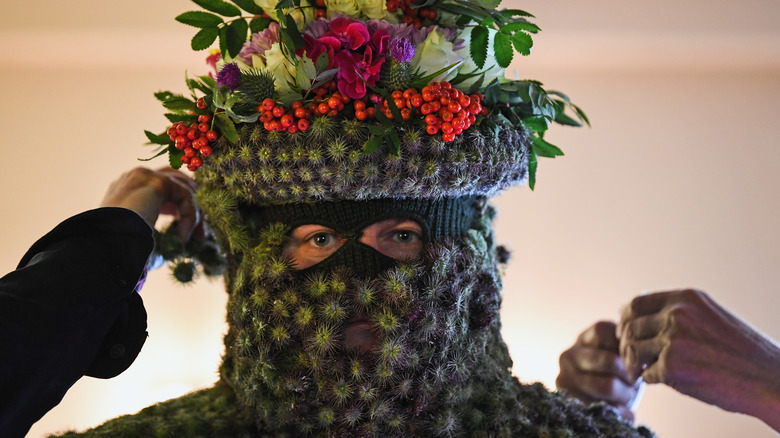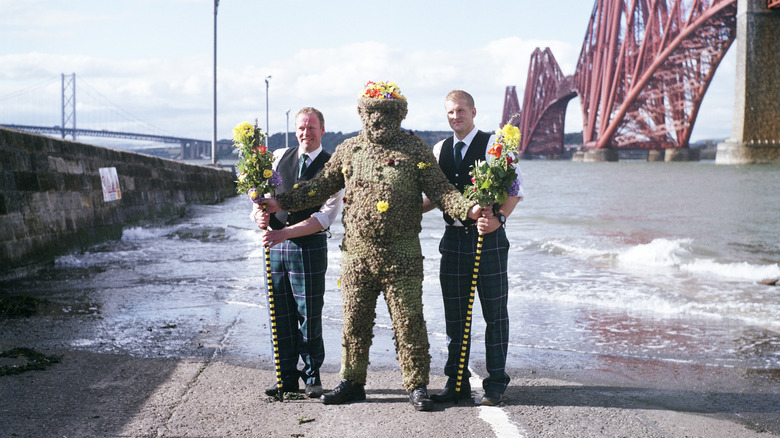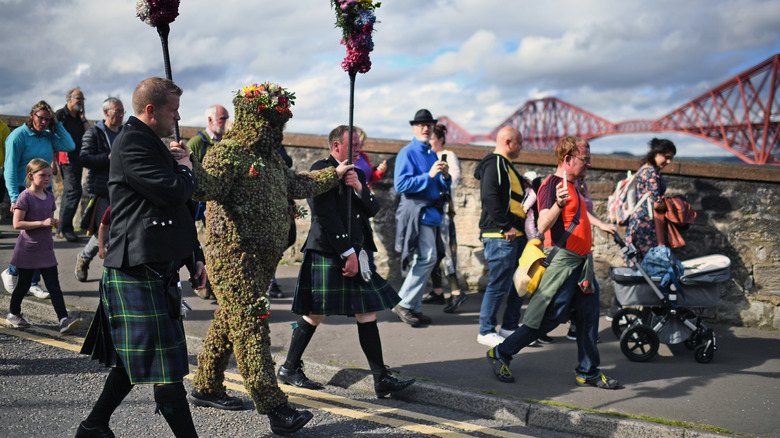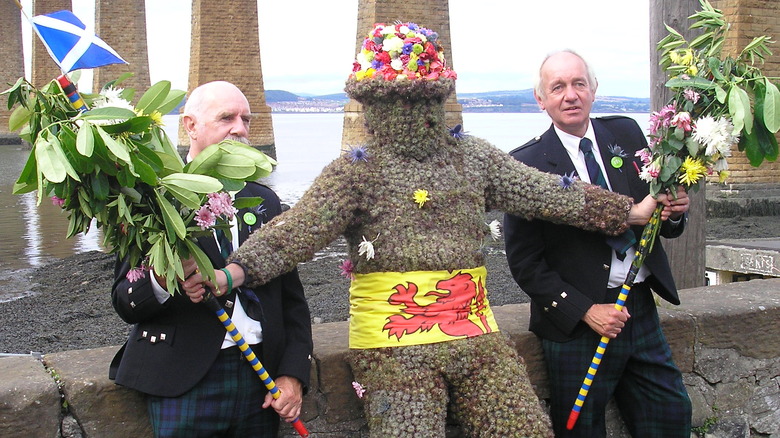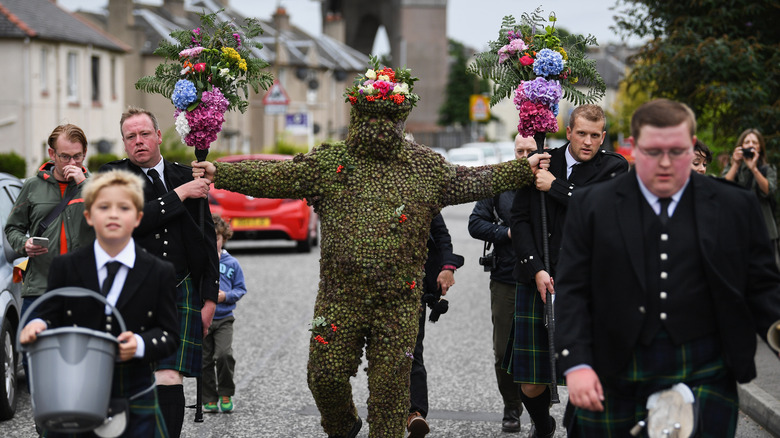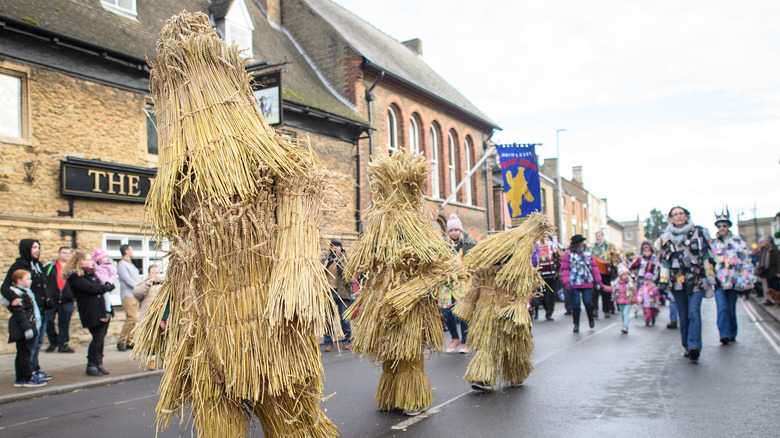The Burry Man: Who Is This Scottish Ritual Figure?
Thanks to the proliferation of information across the internet, previously obscure European rituals and cultic characters have become more widely known to audiences who otherwise would never have been exposed to them. Many such figures — such as Saint Nicholas' dark companion the Krampus and the singing skeleton horse the Mari Lwyd — center around Christmas and the winter months when medieval and early modern people were bored and had nothing else to do. But there's one holiday figure that's made the rounds on Twitter that is focused on the heat of summer: The Burry Man, an uncomfortable fellow dressed from head to toe in prickly plants who walks the streets near Edinburgh, Scotland, for nine hours every August.
As Atlas Obscura explains, the Burry Man — also spelled "Burryman" — can be seen in conjunction with the Ferry Fair Festival held in South Queensferry, a port town on the Firth of Forth near Edinburgh, usually held in the second week of August. On one day of the festival celebrations, a local man, dressed all in burrs, will walk the streets of town for nine hours, accompanied by two attendants who help him hold his arms up. The trio stops at every pub in town to receive donations of money and whisky, which the Burry Man has to drink through a straw. Regular citizens and tourists also make similar gifts in hopes of receiving a blessing of good luck from the Burry Man.
Making the Burry Man costume
According to The Scotsman, the Burry Man costume is made of tens of thousands of burrs from the burdock plant, which are gathered by the man who will wear the costume along with his family and friends. The role of the Burry Man always goes to a man local to the village, and since 2012, the Burry Man suit has been made and worn by Andrew Taylor. The thousands of burrs, gathered from various sources, are then stuck together into around 50 patches about the size of a sheet of notebook paper. The burrs naturally stick together like a kind of Velcro, so no glue or stitching is needed to assemble the costume. These patches are then assembled over the top of a protective suit made from long underwear that also includes a hood and mask, since everything except for the eyes and mouth of the Burry Man is covered.
The costume isn't completely burrs, however. The prickly suit is also dotted with flowers across the body and topped with what essentially looks like a bowler hat made of flowers on the man's head. Additionally, the Burry Man may also wear a wide sash across his waist made from a folded-up Royal Banner of Scotland, which is a flag featuring a red lion on a yellow field. The uncomfortable nature of the prickly burrs means the man walks with attendants holding poles that he uses to keep his arms up, and he has to walk with a stride that makes him waddle with his feet apart like a bear.
The Burry Man walks
The costume of the Burry Man is only part of the celebration. The unique and somewhat startling outfit has to be paired with a specific long-standing ceremony in order to bring about the benefits of good fortune to the people of Queensferry. The BBC explains that the ritual involves the Burry Man proceeding through the streets of South Queensferry along a 7- to 9-mile stretch, traditionally starting in the morning at the Stag Head Hotel, where the final costume assembly takes place. From there, the Burry Man waddles along the streets accompanied by his attendants and preceded by a local child ringing a bell to herald his coming. Along this route, the Burry Man and his entourage stop at more than 20 pubs, and at each one, he is given a drink of whisky through a straw.
The Burry Man is not allowed to talk for this nine-hour stretch, but he is greeted by onlookers along the streets who shout out, "Hip hip hooray, it's the Burryman's day!" Some spectators will offer their own sips of whisky, and others will gather up fallen burrs from the costume, believing that they will bring good luck. While the true original meaning of the Burry Man ritual has been lost to the mists of time, it is generally understood that those who make gifts to the Burry Man are helping to bring good fortune to their village.
History of the Ferry Fair
The Burry Man's procession is an event held in conjunction with the annual Ferry Fair in South Queensferry. According to ICH Scotland, the Ferry Fair has been held in its current form since 1930, but it was originally inaugurated in 1687 when King Charles I granted a charter giving permission to hold the event. These days, the fair is primarily a week-long collection of children's entertainment, including costume contests, wheelbarrow races, face painting, and so on. Local businesses and residential homes decorate festively for the occasion, and there are live performances by musical acts and other entertainers.
The climax of the festivities comes in the election of a Ferry Fair Queen, chosen by local elementary school children. Once a new queen has been chosen, she leads a procession through the town followed by bands, floats, and performers, ending at a stage in the High Street, where the new queen is crowned by a respected local woman known as Our Gracious Lady. The Scots Magazine says that the Burry Man walk takes place on the day before the fair begins (though the Ferry Fair website suggests it takes place the Friday of the fair week). The former outlet says the fair would have originally been held in late July but was pushed back to the second week of August to make sure that the burrs would be fully ripe and ready to become a costume.
What does the Burry Man mean?
"Okay," you may say. "This is all well and good, but what does the Burry Man mean? Why is a man doing this to himself every year?" Well, a great question to which we do not really have a solid answer. While references to the ceremony can be found as far back as the 17th century when the Ferry Fair charter was granted, some people believe that the ritual is much older, and everyone has their own ideas about what it might mean. The Scots Magazine notes that other Scottish fishing communities are known to have had similar good luck figures that would hold a procession in order to ensure good fishing hauls. Likewise, there are those who claim that the Burry Man is a scapegoat-like figure, with the burrs representing the sins of the people of the village, which are then driven out of town. As the magazine notes, however, there is no evidence of the Burry Man being driven out as part of the ceremony, and in fact, people warmly welcome the prickly figure as he makes his rounds.
The Scotsman offers the theory that the Burry Man may simply have been something of a mascot for the fair, going around to collect money for the village to put into the festivities. Or it may have been his job to gather up evil spirits and bad luck before the herring boats set sail. Atlas Obscura notes that some people see a connection with harvest celebrations and pagan rituals of death and rebirth, though this seems incredibly unlikely given that the earliest record of the ceremony was in the modern era.
Similar figures from the British Isles
As strange and unique as the Burry Man may seem, the fact is that there are a number of similar figures from other rural areas and fishing villages throughout Europe. As The Scots Magazine says, the Scottish village of Buckie would have a man covered in burrs and paraded through town in a wheelbarrow in order to bring good luck to their fishermen, and Fraserburgh had a burr-covered man ride a horse through town preceded by a piper. But beyond costumes made of burrs, one strikingly similar ritual is the Straw Bear Festival of Whittlesea in England, which Lonely Planet explains is a harvest festival traditionally held on the day after Plough Monday (the first Monday after Epiphany on January 6, marking the end of the Christmas season), in which people dressed from head to toe in costumes made of straw go around town entertaining people.
Similar straw costumes can also be seen in Irish Wren Day celebrations, held on the day after Christmas. As Smithsonian Magazine explains, on December 26 in Ireland, young boys go around "hunting" the wren (formerly a real wren, now a fake one) and tying it to the top of a pole. These boys, known as Wren Boys, go from house to house carrying the wren dressed in costumes made of straw and masks or faces blackened with burnt cork, singing their Wren Day song and collecting money for charity.
